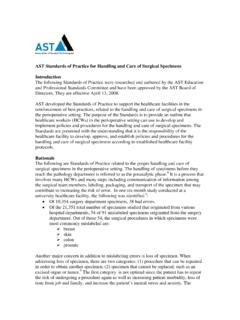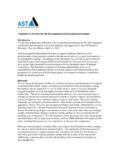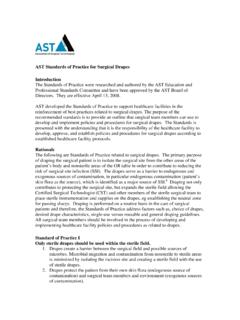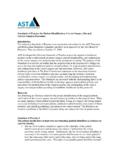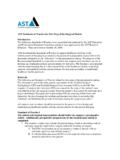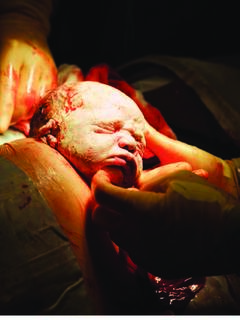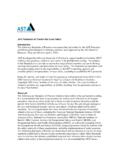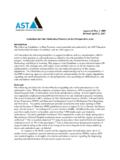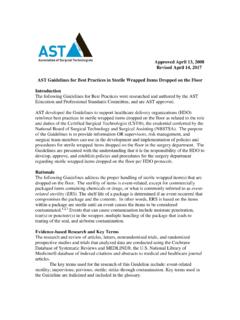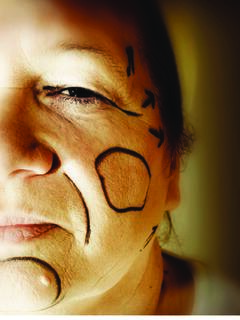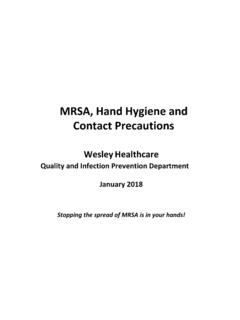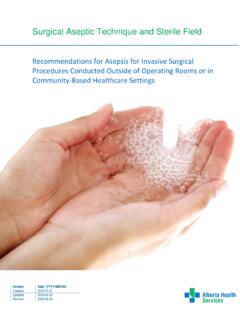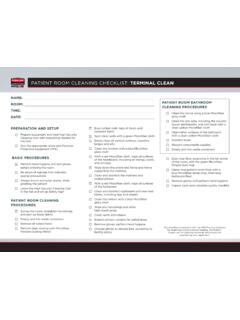Transcription of Standard Surgical Attire and Surgical Scrub
1 AST standards of Practice for Surgical Attire , Surgical Scrub , hand hygiene and Hand Washing Introduction The following recommended standards of practice were researched and authored by the AST Education and Professional standards Committee and have been approved by the AST Board of Directors. They are effective April 13, 2008. AST developed the Recommended standards of Practice to support healthcare facilities in the reinforcement of best practices related to wearing of Surgical Attire and performing the Surgical Scrub in the perioperative setting.
2 The purpose of the Recommended standards is to provide an outline that healthcare workers (HCWs) in the perioperative setting can use to develop and implement policies and procedures for the proper wearing of Surgical Attire and performing the Surgical Scrub . The Recommended standards is presented with the understanding that it is the responsibility of the healthcare facility to develop, approve, and establish policies and procedures for Surgical Attire and performing the Surgical Scrub according to established healthcare facility protocols.
3 Rationale The following are Recommended standards of practice related to properly wearing the Surgical Attire and performing the Surgical Scrub in the perioperative setting. Dating back to the Hungarian physician Ignaz Semmelweis, who advocated and implemented strict hand washing guidelines for medical students, it has long been recognized that the skin is a primary source for harboring microorganisms that represent as being a potential cause of Bacteria residing on the hands of the Surgical team can be the cause of Surgical site infections (SSI).
4 6 When the members of the sterile Surgical team use a non-antimicrobial scrubbing agent, the bacteria rapidly multiply under Surgical gloves (CDC, 2002). Even though the members of the sterile Surgical team wear sterile gowns and gloves, studies have shown that bacterial growth is decreased when an antiseptic scrubbing agent is used when performing the Surgical Scrub , thus reducing the risk of SSI in particular if a glove sustains a puncture or ,36 Healthcare facilities should evaluate and choose Surgical Scrub solutions based on their meeting US Food and Drug Administration (FDA) standards .
5 Ability to decrease to an irreducible minimum the number of bacteria on the hands and forearms immediately after performing the Surgical Scrub , ability to provide persistent antimicrobial activity and to provide long-term cumulative Of those items used to evaluate a Scrub solution, immediate and persistent activity are considered the most important when determining the efficacy of the FDA standards state that solutions used for the Surgical Scrub should substantially reduce microbes that reside on the skin, contain a nonirritating antimicrobial preparation, possess a broad-spectrum of antimicrobial properties, be fast-acting and have persistent, cumulative Additionally.
6 Wearing Surgical Attire has been shown to aid in containing the shedding and dispersal of skin squames into the environment. The human body is a major source of bacterial contamination in the Surgical environment. Surgical site infections (SSI) have been traced to bacteria from the hair, scalp and skin of Surgical The purpose of the Surgical Attire is to protect the patient and staff by maintaining a limited microbial In order to maintain a clean environment and adhere to OSHA regulations, Surgical Attire must be The healthcare facility should establish policies and procedures for evaluating the efficacy of Surgical Attire prior to being purchased, proper wearing of Attire and compliance by the Surgical personnel.
7 In summary, the purposes of the Surgical Scrub and Surgical Attire is to promote patient safety by helping to prevent environmental contamination; prevent the transfer of transient microorganisms and debris from the hands and forearms; decrease the number of resident microorganisms to an irreducible minimum; and inhibit rapid proliferation of microorganisms on the nails, hands and forearms. All surgery department personnel should be involved in the process of developing and implementing healthcare facility policies and procedures for Surgical Attire and performing the Surgical Scrub .
8 Standard of Practice I The proper Surgical Attire should be worn in the semi-restricted and restricted areas of the healthcare facility surgery department. 1. Surgical Attire that should be worn in the semi-restricted and restricted areas of the surgery department includes the head cover, masks, Scrub suit, warm-up jacket, and shoes. A. The Surgical team members are responsible for preventing SSI by properly donning and wearing the appropriate head cover or hood. The Surgical department should follow recommended OSHA and CDC standards for personal protective equipment (PPE).
9 (1) The Surgical head cover or hood should be lint-free and cover all head and facial hear. Head covers prevent the shedding of hair, squamous cells, and/or dandruff onto the Scrub ,17 (2) To prevent shedding onto the Scrub suit, the first item of the Surgical Attire to be donned should be the head ). (3) Surgeons (skull) caps/head covers are not recommended for use. The determination is that the surgeons head cover does not completely cover the hair exposing the patient to the possibility of acquiring a (4) Disposable bouffant and hood head covers offer complete coverage of the head and facial hair and should be worn by all OR personnel.
10 (5) It is recommended that surgery personnel with facial hair wear a disposable hood to completely cover the facial hair. (6) The Surgical department should develop policies and procedures addressing the wearing of head covers by Surgical personnel entering the semi-restricted and restricted areas of the Surgical suite based on OSHA, CDC and APIC standards . (7) The practice of allowing the use or not allowing the use of reusable cloth caps is governed by the healthcare facility policies and procedures. However, it is recommended that reusable cloth covers should not be worn.
